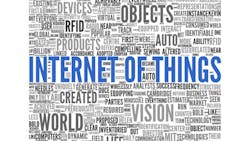One trend that is beginning to rapidly take hold across the technology landscape is the concept of what has been dubbed as the “Internet of Things” or IoT for short, which is essentially the proliferation of web-enabled devices throughout all industries. In fact, Cisco, which was one of the pioneers behind the IoT phenomenon, predicts that by 2020, there will be somewhere between 20 to 50 billion connected devices in use around the world.
If Cisco’s predictions come to fruition, it raises several important questions for the security industry. First, how can organizations using these connected devices ensure that they are not infiltrated by hackers? And secondly, how will the IoT impact the development of security technologies and what benefits will they be able to provide users over the current generation of surveillance, access control, intrusion detection devices, etc. that are already in use?
“This is going to produce a massive amount of data and a massive amount of information,” said Geetha Dabir, vice president and general manager for IoT applications at Cisco. “And this adds complexity to the (network) architecture, as well as the way we view how we do things at Cisco.”
Given some of the vulnerabilities of connected devices that have come to light, especially in the healthcare sector where it was recently shown that life-saving medical devices such as insulin pumps and pacemakers could be tampered with by hackers, Dabir said alleviating these concerns among end users is a top priority.
“This is one of the most important issues that many of our customers are facing and are concerned and worried about,” said Dabir. “Cisco offers cybersecurity at the edge, in the middle and at the central data center or central location and the type of security required for this is somewhat different and we are working on solutions for that. For example, if you look at a factory floor, you have your machines and you have your phones, so if any of these devices get infected you can shut it off. But, in the case of IoT solutions, you cannot do that. Liability and availability become very important, so we are working on offering firewall solutions that will ensure availability of the devices and equipment.”
Despite the risks, the benefits of using IoT devices within security and other industries could far outweigh the threats posed by online criminals.
“You can look at cameras as very powerful sensors,” explained Dabir. “If you look at government applications, cameras are being used to ensure the safety of people. In one city use case, a lot of data is being collected from the safety cameras that are there, but besides that, there is sensor information that is being collected from bridges and other places such as flood detection. There is also information being collected in cities based on Twitter and emails and things like that that are commonly available. And, based on all of this information being gathered, they are able to actually detect (public) unrest because of dissatisfaction and are able to address it.”
Historically, Dabir said that Cisco has been a “strong leader” when it comes to providing solutions to various manufacturing facilities, campuses and data centers. However, as the company makes its push into the IoT space, she said that they’ve had to design the architecture of their products to be more open.
“The most important element of everything is to provide more of an open platform that allows for strong APIs for third-party ecosystem partners to be able to connect to (our products),” she explained.
Dabir said that Cisco has a wide range of safety and security products associated with the IoT including its Video Surveillance Manager VMS software; IPICS (IP Interoperability and Collaboration System), which enables interoperability between communication devices such as cell phones and IP-based phones and radios; standard, as well as high-definition IP cameras; and, Cisco Physical Access Manager software. According to Dabir, one of the key elements of Cisco’s IoT security solutions is the company’s Medianet architecture, which allows an IP endpoint to interact with the network, enabling the automatic configuring of cameras and the quick diagnosis of trouble spots in the network.
Earlier this month, Cisco announced that it is expanding its open IP cameras platform to include edge-based storage and application development. Developers can also embed instant connect push-to-talk for mobile technology. Additionally, the company is expanding its ecosystem with the addition of new participants. New ecosystem members include: Intuvision, Live Action, AgentVi and iOmniscient, AGT International, S2 Security, Etherstack, Tait, IP Trade, and Technuf.
Cisco is not the only company looking to capitalize on the IoT in the security industry. HID recently announced it will begin offering its Trusted Tag Services offering. By combining trusted tags with existing secure cloud authentication services, this solution confers everyday objects with unique and trusted identities that can be read by NFC-enabled mobile devices in a wide variety of IoT applications.
“By enabling smartphones to effortlessly double as tag readers and communicate with our authentication service, HID Global is helping organizations to easily expand into the IoT,” said Marc Bielmann, vice president of identification technologies with HID Global. “HID Trusted Tag Services enable trusted transactions and instill confidence that individuals scanning the tags are both who and where they claim to be. The solution is based on the same proven technology used in online banking, and it is secure, trusted and easy to use.”
Whether it’s through the use of more advanced surveillance cameras or NFC-enabled smartphones that can double as tag readers, the Internet of Things concept is already growing in prominence within the security industry and, as end users continue to clamor for products that help them deliver more ROI to their respective organizations, this trend is likely to continue for some time.



